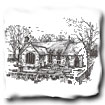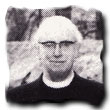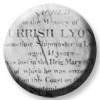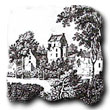History of Deskford Castle
Deskford Castle or Tower was built in the late 14th century by the Sinclairs of Findlater and Deskford, a branch of the St. Clairs of Roslyn near Edinburgh.
The last of this line, Sir John Sinclair resided in Findlater Castle on the cliff tops until tragedy struck. His only son fell from the arms of his nurse and was dashed to death on the rocks below. The nurse we are told, in her grief ,threw herself to the same fate.
The family moved inland to Deskford Castle but further tragedy awaited them. In 1411 Sir John Sinclair was killed at the battle of Harlaw leaving no male heir.
The estates of Deskford and Findlater were inherited by his eldest daughter Margaret who married Sir William Ogilvie in 1437 thus bringing to an end the Sinclair Line and sowing the seed of the Seafield Dynasty.
Deskford Castle as portrayed by Charles Cordiner in 1790, was a fine example of a Tower House with four storeys rising above a massive barrel- vaulted entrance chamber. Crowning this edifice was a Garret storey taking it up to more than seventy feet with a commanding view of the Strath of Deskford.
The whole stucture was connected by means of a semi- circular tower on the South West’ corner. The entrance was in the middle of the South wall, through what was to become Deskford Church ,but what was originally part of the grand extensions and improvements of 1560.
At this time the Tower was described as a ‘Commodious mansion house’ with its new quadrangle of buildings surrounding a huge cobbled courtyard. In the Chapel an aumbry was created to celebrate the wedding of Alexander Ogilvie to Elizabeth Gordon dated 1551.
This Sacrament House is regarded as one of the finest in Scotland. There were also formal gardens and a large walled orchard which became famous for having the largest girth ash tree in Scotland dedicated to St.John.
At some point, probably the Reformation, the Chapel was expanded into what we now see; a simple sixty foot long basic hall of worship.
The original Tower entrance was filled in and an alternative created in the West wall. These changes of use could take place because the Ogilvies had moved to Cullen House leaving Deskford Castle to pass into obscurity and final destruction.
Well not quite. The main wing of the complex has survived and is now the Muckle Hoose and although the old Tower was demolished to protect the Church it still stands some 20 feet high.
Tom Johnston







